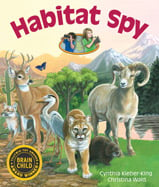Alignment to CORE and NGSS Standards

| Grade | Number | Standard |
|---|---|---|
| 1 | NGSS: 1-LS1.A: | All organisms have external parts. Different animals use their body parts in different ways to see, hear, grasp objects, protect themselves, move from place to place, and seek, find, and take in food, water and air. Plants also have different parts (roots, stems, leaves, flowers, fruits) that help them survive and grow. (1-LS1-1) |
| 1 | NGSS: 1-LS1.D: | Animals have body parts that capture and convey different kinds of information needed for growth and survival. Animals respond to these inputs with behaviors that help them survive. Plants also respond to some external inputs. (senses) (1-LS1-1) |
| 1 | RL.1.4 | Identify words and phrases in stories or poems that suggest feelings or appeal to the senses. |
| 2 | NGSS: 2-ESS2.C | Water is found in the ocean, rivers, lakes, and ponds. Water exists as solid ice and in liquid form. (2-ESS2-3) |
| 2 | NGSS: 2-LS4.D | There are many different kinds of living things in any area, and they exist in different places on land and in water. Classification (2-LS4-1) |
| 2 | RI.2.3 | Describe the connection between scientific ideas or concepts, or steps in technical procedures in a text: Earth processes: quickly/slowly, wind/water shape land, plate tectonics, maps, water: ocean/rivers/lakes-solid or liquid, STEM: drawings, plant basic needs, seed dispersal, biodiversity, state of matter: solid/liquid, small objects make larger, heating/cooling substance causes observable change, add/subtract 100-20 mentally, equal groups for multiplication foundation, odd/even numbers, place value 3 digits, skip counting, measure length using 2 different measurements (inches/feet/yard/cm/m), compare objects by measurement, number line, time to 5 minutes, money/currency, line plot, picture graph, bar graph 4 categories, shapes/angles/number faces, divide shapes into halves, thirds, quarters, fables/folktales from diverse cultures, rhyme and rhythm, compare two/more versions same story, collective nouns |
| 2 | RI.2.4 | Determine the meaning of words and phrases in a text relevant to a grade 2 topic or subject area: Earth processes: quickly/slowly, wind/water shape land, plate tectonics, maps, water: ocean/rivers/lakes-solid or liquid, STEM: drawings, plant basic needs, seed dispersal, biodiversity, state of matter: solid/liquid, small objects make larger, heating/cooling substance causes observable change, add/subtract 100-20 mentally, equal groups for multiplication foundation, odd/even numbers, place value 3 digits, skip counting, measure length using 2 different measurements (inches/feet/yard/cm/m), compare objects by measurement, number line, time to 5 minutes, money/currency, line plot, picture graph, bar graph 4 categories, shapes/angles/number faces, divide shapes into halves, thirds, quarters, fables/folktales from diverse cultures, rhyme and rhythm, compare two/more versions same story, collective nouns |
| 2 | RL.2.4 | Describe how words and phrases (e.g., regular beats, alliteration, rhymes, repeated lines) supply rhythm and meaning in a story, poem, or song. |
| 3 | RF.3.4a-AR/ATOS | Read grade-level text with purpose and understanding. AR |
| 3 | RF.3.4a-Guided Reading | Read grade-level text with purpose and understanding. Guided Reading |
| 3 | RF.3.4a-Reading Counts! | Read grade-level text with purpose and understanding. Reading Counts! |
| 3 | RI.3.10-AR/ATOS | By the end of the year, read and comprehend informational texts, including history/social studies, science, and technical texts, at the high end of the grades 2_3 text complexity band independently and proficiently. AR |
| 3 | RI.3.10-Guided Reading | By the end of the year, read and comprehend informational texts, including history/social studies, science, and technical texts, at the high end of the grades 2_3 text complexity band independently and proficiently. Guided Reading |
| 3 | RI.3.10-Reading Counts! | By the end of the year, read and comprehend informational texts, including history/social studies, science, and technical texts, at the high end of the grades 2_3 text complexity band independently and proficiently. Reading Counts! |
| 3 | RL.3.10-AR/ATOS | By the end of the year, read and comprehend literature, including stories, dramas, and poetry, at the high end of the grades 2_3 text complexity band independently and proficiently. AR |
| 3 | RL.3.10-Guided Reading | By the end of the year, read and comprehend literature, including stories, dramas, and poetry, at the high end of the grades 2_3 text complexity band independently and proficiently. Guided Reading |
| 3 | RL.3.10-Reading Counts! | By the end of the year, read and comprehend literature, including stories, dramas, and poetry, at the high end of the grades 2_3 text complexity band independently and proficiently. Reading Counts! |
| K | NGSS: K-ESS3.A1 | Living things need water, air, and resources from the land, and they live in places that have the things they need. (K-ESS3-1) |
| K | RF.K.2a | Recognize and produce rhyming words. |
| K, 2 | K-4)3.4.2 | Places have physical and human characteristics (climate, ecosystems around the world) |
| K, 2 | K-4)3.8.1 | The components of ecosystems: biodiversity, soil, climate |
| K, 2 | K-4)3.8.2 | The characteristics of ecosystems: specific types of plants, climate, and soil found in specific ecosystems (rainforest, desert, decidious forest, etc.) |
| K, 2 | K-4)3.8.3 | The characteristics of biomes (large region of ecosystems with similar climate and vegetation characteristics: deserts, grasslands, savannahs, temperate forests, tropical forests, arctic tundra) |
| K-5 | Dewey 577.1 | 577.1 |